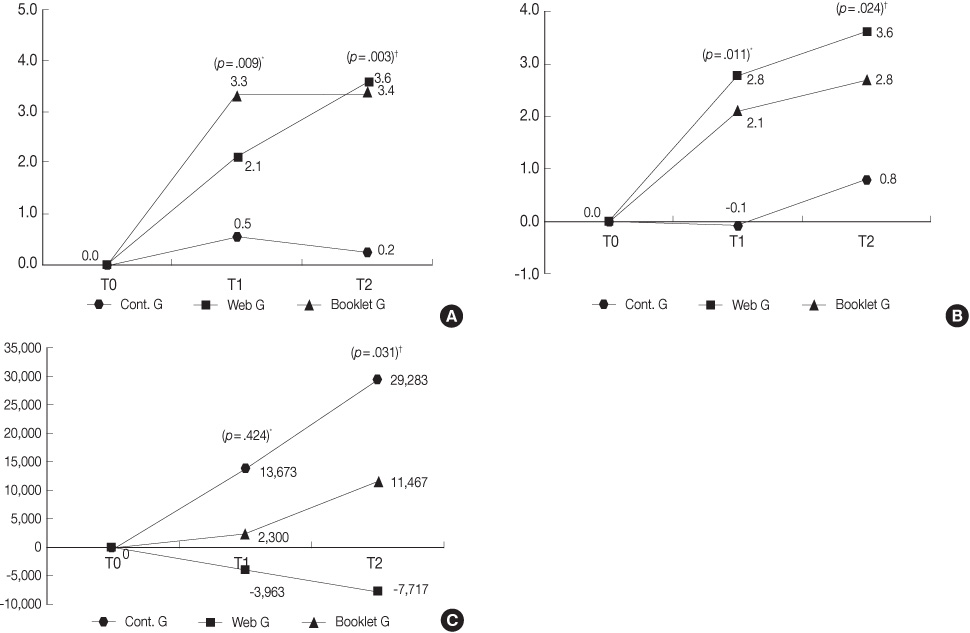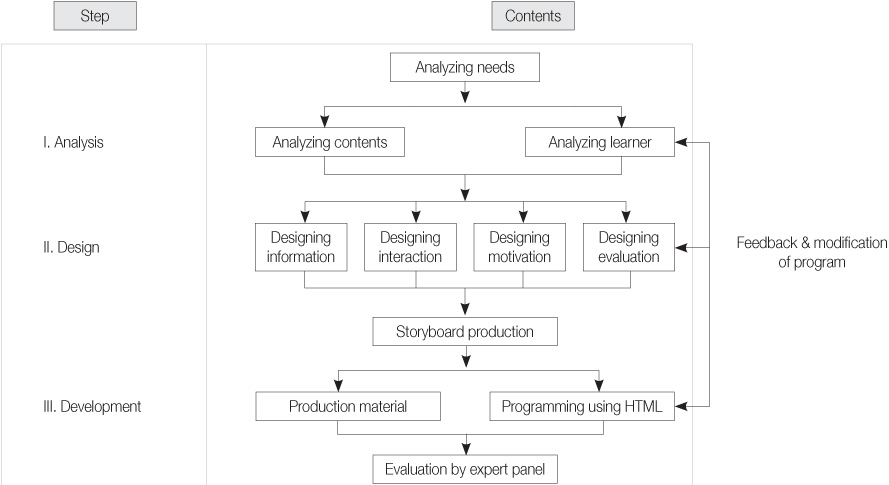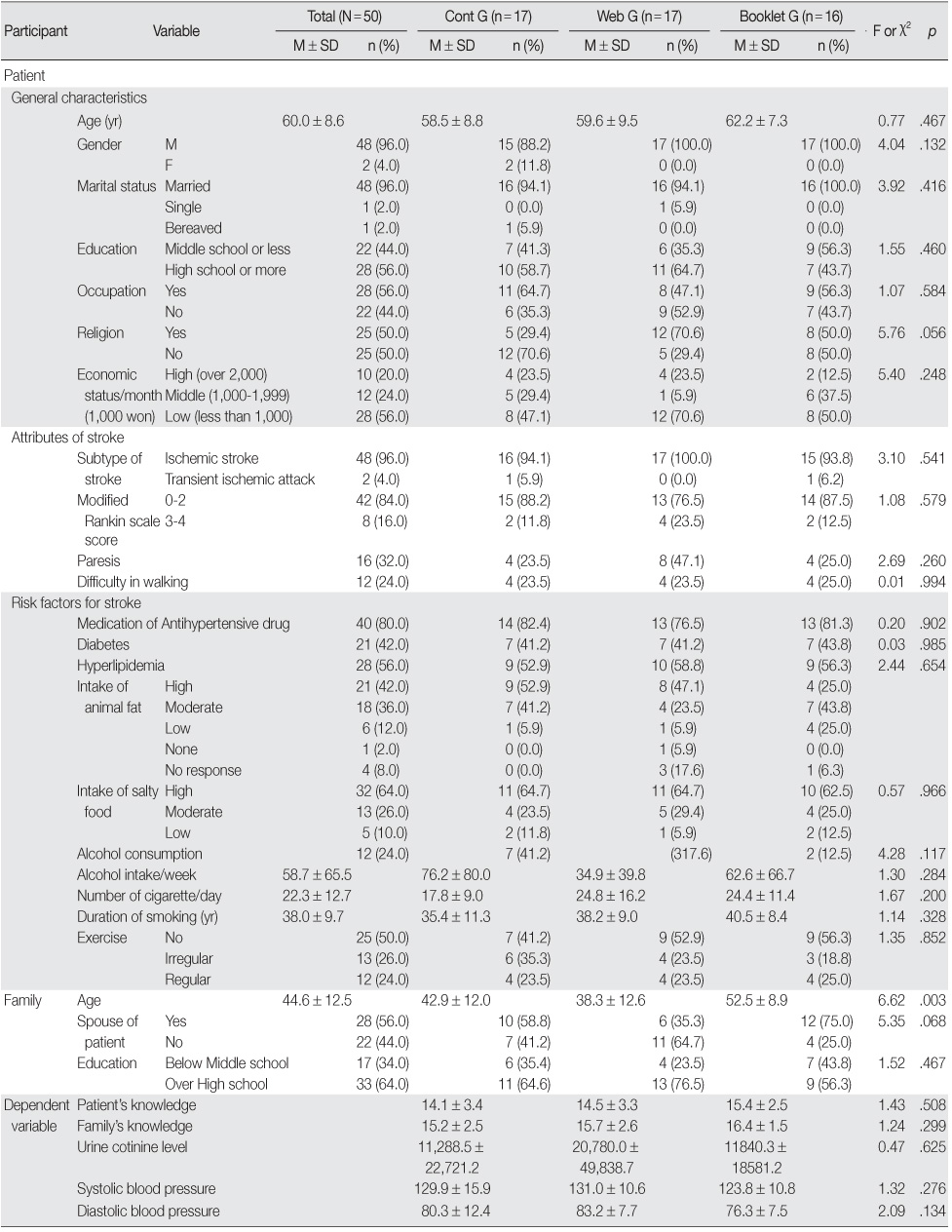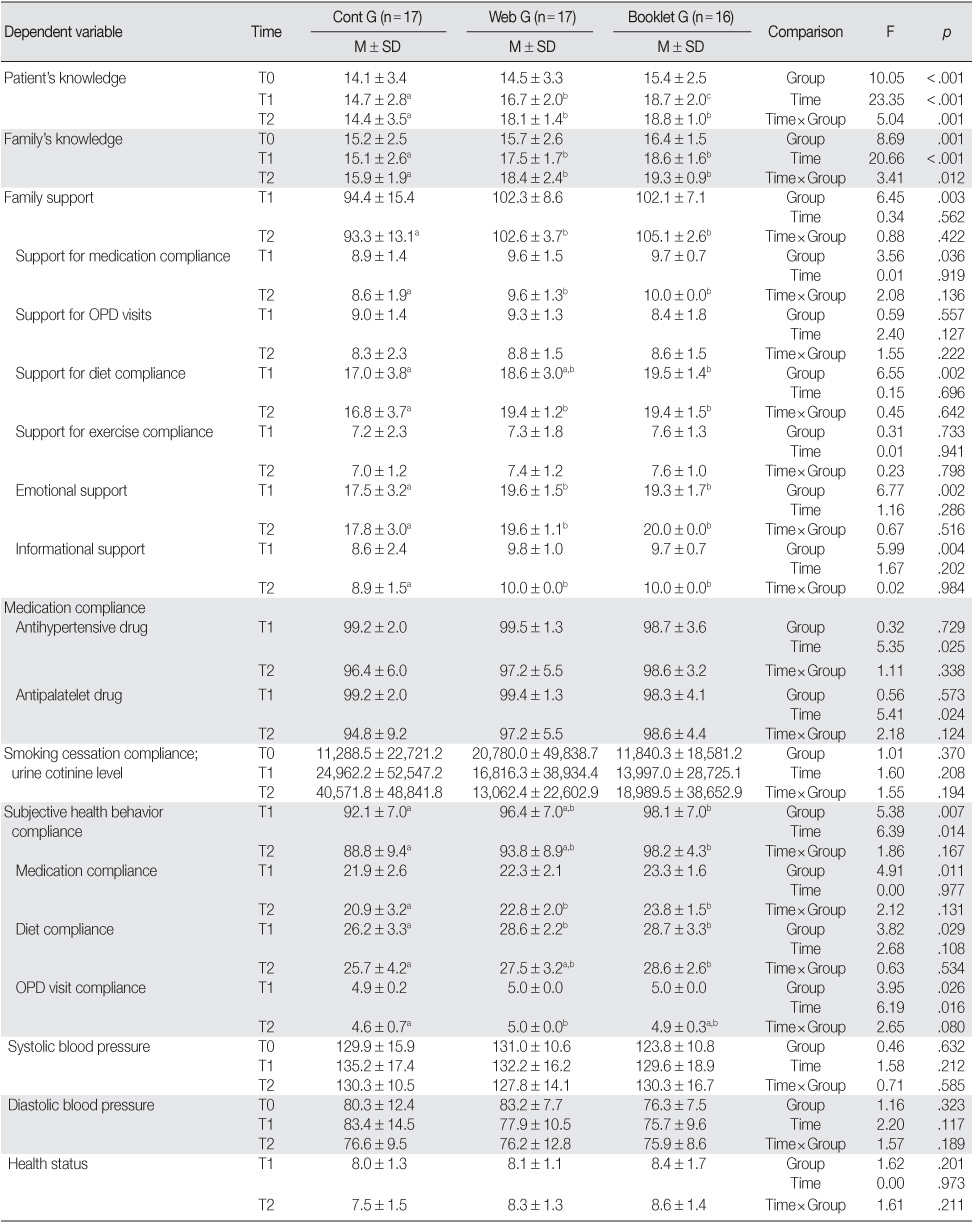Articles
- Page Path
- HOME > J Korean Acad Nurs > Volume 41(1); 2011 > Article
-
Original Article
- Development and Evaluation of a Web-based Education Program to Prevent Secondary Stroke
- Chul-Gyu Kim, Hyeoun-Ae Park
-
Journal of Korean Academy of Nursing 2011;41(1):47-60.
DOI: https://doi.org/10.4040/jkan.2011.41.1.47
Published online: February 28, 2011
1Full-time Lecturer, Department of Nursing, Cheongju University, Cheongju, Korea.
2Professor, College of Nursing, Seoul National University, Seoul, Korea.
- Address reprint requests to: Park, Hyeoun-Ae College of Nursing, Seoul National University, 28 Yeongeon-dong, Jongno-gu, Seoul 110-744, Korea. Tel: +82-2-740-8827, Fax: +82-2-765-4103, hapark@snu.ac.kr
© 2011 Korean Society of Nursing Science
Abstract
-
Purpose
- This study was conducted to develop and evaluate a web-based education program for secondary stroke prevention.
-
Methods
- A web-based secondary stroke prevention education program was developed using the system's life cycle methods and evaluated by comparing the effects of education among three groups, a web group, a booklet group and a control group.
-
Results
- Knowledge level of both patients and family, as well as some health behavior compliance in the web-based and booklet education groups were significantly higher than those of the control group. Family support in the web-based and booklet education groups was significantly higher than that of the control group after 12 weeks. The urine cotinine level in the web-based education group was significantly lower than that of the control group after 12 weeks. Medication adherence, blood pressure and perceived health status were not statistically different among the three groups at any time.
-
Conclusion
- Web-based and booklet education programs were equally effective regarding the level of knowledge of patients and their families, family support, health behavior compliance, and urine cotinine level. These results demonstrate the potential use of a web-based education program for secondary stroke prevention.
This article is based on a part of the first author's doctoral thesis from Seoul National University.
- 1. Benowitz NL. Cotinine as a biomarker of environmental tobacco smoke exposure. Epidemiologic Reviews. 1996;18:188–204.ArticlePubMed
- 2. Bigelow JH, Fonkych K, Fung C, Wang J. Analysis of healthcare interventions that change patient trajectories. 2005;Santa Monica, CA, RAND Corporation.
- 3. Carlsson R, Lindberg G, Westin L, Israelsson B. Influence of coronary nursing management follow up on lifestyle after acute myocardial infarction. Heart. 1997;77:256–259.ArticlePubMedPMC
- 4. Choi-Kwon S, Kwon SU, Kim JS. Compliance with risk factor modification: Early-onset versus late-onset stroke patients. European Neurology. 2005;54:204–211.ArticlePubMedPDF
- 5. Choi S, Kwon SU, Ahn JS, Kim JS. Different perspectives of stroke education between patients and medical personnel. Korean Journal of Stroke. 2002;4:78–87.
- 6. Cohen J. Statistical power analysis for the behavioral sciences. 1988;2nd ed. Hillsdale, NJ, Erlbaum.
- 7. Collins TC, Petersen NJ, Menke TJ, Souchek J, Foster W, Ashton CM. Short-term, intermediate-term, and long-term mortality in patients hospitalized for stroke. Journal of Clinical Epidemiology. 2003;56:81–87.ArticlePubMed
- 8. Han AK. Effects of a family participated education program on the self care behavior and family support behavior of cardiac patients. 1998;Seoul, Yonsei University. Unpublished doctoral dissertation.
- 9. Jo HS, Kim KJ. The effects of a cardiac rehabilitation program on health behavior compliance, cardiovascular function, and quality of life for the patients with ischemic heart disease. Journal of Korean Academy of Nursing. 2000;30:560–570.ArticlePDF
- 10. Jung YY. The development of a internet-based computer assisted instruction program and analysis of its educational effects on patients with coronary artery disease. 2002;Seoul, Seoul National University. Unpublished doctoral dissertation.
- 11. Kang SM. An effect of the secondary stroke prevention education program on self-care of acute ischemic stroke patients. 2005;Chungju, Konkuk University. Unpublished master's thesis.
- 12. Kim HJ. The effect of health promotion program for stroke patient in home. 2004;Daegu, Keimyung University. Unpublished doctoral dissertation.
- 13. Kim HS. Effects of web-based diabetic education in obese diabetic patients. Journal of Korean Academy of Nursing. 2005;35:924–930.ArticlePubMedPDF
- 14. Kim MH. An explanatory model for health-promoting behaviors in patients living at home who have post stroke hemiplegia. Journal of Korean Academy of Nursing. 2006;36:1065–1075.ArticlePubMedPDF
- 15. Koh IS, Kim HC, Kwon SB, Hwang SH, Kwon KH, Kim SM, et al. The compliance of stroke patients for secondary prevention: In Seoul & Kyunggi province. Journal of the Korean Neurological Association. 1999;17:472–477.
- 16. Korea Centers for Disease Control and Prevention. 2008 Public health statistics. 2009;Seoul, Author.
- 17. Lawton MP, Moss M, Fulcomer M, Kleban MH. A research and service oriented multilevel assessment instrument. Journal of Gerontology. 1982;37:91–99.ArticlePubMed
- 18. Lee BR, Yu KH, Ma HI, Jung S, Jung S, Lee BC. The compliance of stroke patients for secondary prevention in newly developed city, Pyungchon. Korean Journal of Stroke. 2000;2:158–163.
- 19. Lorig KR, Ritter PL, Laurent DD, Plant K. Internet-based chronic disease self-management: A randomized trial. Medical Care. 2006;44:964–971.PubMed
- 20. Modrego PJ, Pina MA, Fraj MM, Llorens N. Type, causes, and prognosis of stroke recurrence in the province of Teruel, Spain. A 5-year analysis. Neurological Sciences. 2000;21:355–360.ArticlePubMedPDF
- 21. Na IJ. Web-based education. 1999;Seoul, Kyouook Kwahak Sa.
- 22. Disease statistics. National Health Insurance Corporation. 2010;08 09 Retrieved August 9, 2010. from http://www.nhic.or.kr/portal/site/main/menuitem.18832217ea22fd38b31148b4062310a0.
- 23. Ovbiagele B, Saver JL, Fredieu A, Suzuki S, Selco S, Rajajee V, et al. In-hospital initiation of secondary stroke prevention therapies yields high rates of adherence at follow-up. Stroke. 2004;35:2879–2883.ArticlePubMed
- 24. Park HA, Kim HJ, Song MS, Song TM, Chung YC. Development of a web-based health information service system for health promotion in the elderly. Journal of Korean Society of Medical Informatics. 2002;8(3):37–45.ArticlePDF
- 25. Bak HK. The effects of the health promotion program on functional status of the in-house stroke patients. Korean Journal of Rehabilitation Nursing. 2003;6:213–225.
- 26. Rudd AG, Lowe D, Hoffman A, Irwin P, Pearson M. Secondary prevention for stroke in the United Kingdom: Results from the national sentinel audit of stroke. Age and Ageing. 2004;33:280–286.ArticlePubMed
- 27. 2008 Report on the cause of death statistics. Statistics Korea. 2009;09 20 Retrieved September 20, 2009. from http://www.kostat.go.kr/nso_main/nsoMainAction.do?method=search&catgrp=nso2009&catid1=k090000&catid2=k09i0000&forward=search.
- 28. Steele JM, Ruzicki D. An evaluation of the effectiveness of cardiac teaching during hospitalization. Heart & Lung. 1987;16:306–311.
- 29. Stein J. In: Stroke recovery µ rehabilitation. 2009;New York, YN, Demos Medical Publishing.
- 30. Yoo SH, Kang DW, Kwon SU, Kim JS. The secondary prevention of stroke: Attitude of patients admitted to a tertiary hospital. Korean Journal of Stroke. 2005;7:78–86.
REFERENCES

Figure & Data
REFERENCES
Citations

- Effects of the Fear of Stroke Recurrence and a Sense of Coherence on Health Behavior Compliance among Patients Treated for Ischemic Stroke
Seyun Kim, Jong-Eun Lee
The Korean Journal of Rehabilitation Nursing.2025; 28(1): 20. CrossRef - Development and Evaluation of a Mobile Application to Prevent Recurrent Stroke by Enhancing Self-management on Health Outcomes for Stroke Survivors
Young Ju Jeong, Hee Sun Kim, Hyun Goo Kang
CIN: Computers, Informatics, Nursing.2024; 42(1): 53. CrossRef - Impact of Mobile Health Literacy, Stroke-Related Health Knowledge, Health Beliefs, and Self-Efficacy on the Self-Care Behavior of Patients with Stroke
Hana Kim, Aro Han, Hyunjung Lee, Jiwoo Choi, Hyohjung Lee, Mi-Kyoung Cho
Healthcare.2024; 12(19): 1913. CrossRef - Telerehabilitation for Family Caregivers of Stroke Survivors: A Systematic Review and Meta-Analysis
Wen-Jing Sun, Yuan-Yuan Song, Cong Wang, Yan Jiang, Wen-Yao Cui, Wen-Jie Liu, Yan Liu, Nabeel Al-Yateem
Journal of Nursing Management.2023; 2023: 1. CrossRef - Medication self-management interventions for persons with stroke: A scoping review
Lauren Cadel, Stephanie R. Cimino, Glyneva Bradley-Ridout, Sander L. Hitzig, Tejal Patel, Chester H. Ho, Tanya L. Packer, Aisha K. Lofters, Shoshana Hahn-Goldberg, Lisa M. McCarthy, Sara J. T. Guilcher, Jonathan Bayuo
PLOS ONE.2023; 18(5): e0285483. CrossRef - Siroz Hastalığı Olan Bireyler İçin Web Tabanlı Hemşirelik Eğitim Programı
Servet KALYONCUO, Pınar TEKİNSOY KARTIN
Sağlık Akademisi Kastamonu.2023; 8(3): 569. CrossRef - Effect of a Hospital-To-Home Transitional Intervention Based on an Interaction Model of Client Health Behavior for Adult Patients with Stroke
Su-Jin Cho, Sung Reul Kim, Kyung-Hee Cho, Nah-Mee Shin, Won-Oak Oh
Journal of Community Health Nursing.2023; 40(4): 273. CrossRef - Development and evaluation of the efficacy of a web-based education program among cancer patients undergoing treatment with systemic chemotherapy: a randomized controlled trial
Hicran Bektas, Hasan Senol Coskun, Fatma Arikan, Keziban Ozcan, Aysel Tekeli, Yasemin Kondak, Merve Gozde Sezgin, Elcin Yangec, Simge Kalav
Supportive Care in Cancer.2022; 30(7): 6021. CrossRef - COMPARISON OF THE EFFECTS OF WEB-BASED AND FACE-TO-FACE TRAINING ON THE SELF-EFFICACY AND HEALTH LITERACY OF PATIENTS WITH HYPERTENSION: A QUASI-EXPERIMENTAL TRIAL
Nihan Türkoğlu, Dilek Kılıc
Eskişehir Türk Dünyası Uygulama ve Araştırma Merkezi Halk Sağlığı Dergisi.2022; 7(1): 15. CrossRef - Information provision for stroke survivors and their carers
Thomas F Crocker, Lesley Brown, Natalie Lam, Faye Wray, Peter Knapp, Anne Forster
Cochrane Database of Systematic Reviews.2021;[Epub] CrossRef - Factors Influencing Health Behavior Compliance in Adult Moyamoya Patients
Bo Eun Kim, Ju-Eun Song
Journal of Korean Academy of Nursing.2021; 51(1): 80. CrossRef - Factors Affecting Health Behavior of Patients with Stroke: Focusing on Health Literacy of Patients and Family Caregivers
Jimin Jeong, Jieun Cha
Korean Journal of Adult Nursing.2020; 32(6): 632. CrossRef - Effects of the Health Literacy and Knowledge on Adherence to Self-care Behavior among Elderly with Ischemic Stroke Visiting Local General Hospitals
Young-Nam Park, Chul-Gyu Kim
Korean Journal of Adult Nursing.2019; 31(5): 573. CrossRef - Self-Care Performance of Middle-Aged Stroke Patients in Korea
Dong Eun Jang, Juh Hyun Shin
Clinical Nursing Research.2019; 28(3): 263. CrossRef - The Relationship Between Educational Needs and the Caregiving Burden in Stroke Patients’ Primary Caregivers
Un-Kyeung Kim, Hye-Yon Yu
Quality Improvement in Health Care.2019; 25(1): 29. CrossRef - Development of Pre-discharge Group Education Program for Liver Transplant Patients
Ji Seon Yun, Kyung Choon Lim, Jae Sim Jeong, Hea Seon Ha, Jung Ja Hong, Soon Haeng Lee, Lee Young Kim, Yeon Hee Kim, Shin Hwang
Korean Journal of Transplantation.2017; 31(1): 34. CrossRef - Effects of in-Person, in-Hospital Education for Stroke Patients by an Education-Specialized Nurse
Young-Hoon Lee, Gyung-Jae Oh, Su-Jin Kang, Hye-In Yu, Kwang-Ho Cho, Hak-Seung Lee, Jin-Sung Cheong, Hyun Young Park
Journal of the Korean Neurological Association.2016; 34(4): 333. CrossRef - Self management programmes for quality of life in people with stroke
Caroline E Fryer, Julie A Luker, Michelle N McDonnell, Susan L Hillier
Cochrane Database of Systematic Reviews.2016;[Epub] CrossRef - Effect of Stroke Prevention Program for The Elderly in The Rural Area
Mal-Soon Kang
Journal of the Korea Academia-Industrial cooperation Society.2015; 16(4): 2620. CrossRef - The effect of a web‐based education programme (WBEP) on disease severity, quality of life and mothers' self‐efficacy in children with atopic dermatitis
Hae Kyoung Son, Jiyoung Lim
Journal of Advanced Nursing.2014; 70(10): 2326. CrossRef - Effectiveness of a Self-management Program using Goal Setting based on a G-AP for Patients after a Stroke
Min Gyeong Park, Yeongmi Ha
Journal of Korean Academy of Nursing.2014; 44(5): 581. CrossRef - The Effects of Individualized Education on Stroke Patients' Post-discharge Anxiety and Self-care Compliance
Hyoung-Sook Park, Mee-Hun Lee, Jae-Hyun Ha
The Korean Journal of Rehabilitation Nursing.2013; 16(1): 1. CrossRef - The Effects of Self-help Management Program on Knowledge about Stroke, Self-efficacy and Self-esteem in People with Stroke
Koung-Oh Chang, Jung Yeon Park
Journal of muscle and joint health.2013; 20(1): 1. CrossRef - The Lifestyle Modification Coaching Program for Secondary Stroke Prevention
Heejeong Kim, Oksoo Kim
Journal of Korean Academy of Nursing.2013; 43(3): 331. CrossRef - Information provision for stroke patients and their caregivers
Anne Forster, Lesley Brown, Jane Smith, Allan House, Peter Knapp, John J Wright, John Young
Cochrane Database of Systematic Reviews.2012;[Epub] CrossRef


Figure 1
Figure 2
Homogeneity Test of General Characteristics of Participants and Dependent Variables
Cont G=Control group; Web G=web education group; Booklet G=booklet education group.
Comparison of Outcomes by Education Groups (N=50)
Cont G=Control group; Web G=web education group; Booklet G=booklet education group; T1: 4 weeks after intervention; T2: 12 weeks after intervention; OPD=out-patient department; a,b,cDuncan Grouping.
Cont G=Control group; Web G=web education group; Booklet G=booklet education group.
Cont G=Control group; Web G=web education group; Booklet G=booklet education group; T1: 4 weeks after intervention; T2: 12 weeks after intervention;
OPD=out-patient department; a,b,cDuncan Grouping.
 KSNS
KSNS
 E-SUBMISSION
E-SUBMISSION



 Cite
Cite

